Thesis
Gesture and line
Elemental forms Whole making Dual resonance Spontaneous forming
The looping gesture of a Great Ape traces a cross in the sand. An 'X' marks his spot (Figure 4.1).

Figure 4.1. Lisa Roberts, Trace forms of Great Ape Gesture, Animation (2007)
Arts educator and researcher, John Sydney Matthews, has identified marks and gestures of Great Apes and children as possible early intentional expressions of personal space (Sydney Matthews, 2007) . He observed and recorded Great Apes performing a swinging gesture with their arms that traces a looping form in the sand.
After studying the gestures used by apes and children as they draw, arts researcher Elizabeth Watts observes that
Movement is the means by which marks are made, and at this very basic level of spontaneous mark-making the pleasing movement sensations probably motivate the early marks, and remain at least as important as the marks themselves to both ape and child for some time (Watts, 1977, p.10).
As well as being pleasurable in its own right, awareness of movement sensations has been vital for human survival since ancient times. 'As every predator knows, movement is revealing' (Lovelock, 2009, p.125).
Cognitive neuroscientist, Michael Corballis, proposes that '[m]anual gestures are perhaps the ancestors of human spoken languages' (Corballis, 1999). If this form of body knowledge precedes mark-making and spoken language, meanings conveyed by gestures can add depths of understanding to symbols and words.
John D. Barrow proposes that
The infinity sign has a dual resonance. It combines the mystic attraction of the great unknown and unknowable with the cold precision of mathematics and the desire to describe the unimaginable. The ribbon like figure of the figure-eight on its side is an ancient symbol, a shadow of the ancient ourobos symbol of the snake eating its tail ... it provided the mysterious cross of St Boniface in early Christian tradition (Barrow, 2008, p.339).
The infinity sign can convey profound meanings that transcend logical description. Like the cross drawn by Eastaugh (Figure 3.26), it resonates with objective and subjective references. Visceral levels of connection can occur when mystery is attached to symbols. If earliest knowledge of our environment is through gesture, then this knowledge may tap in to what Freud identified as the 'archaeology of the mind' (Freud in Burke, 2008). Arts researcher, Janine Bourke, explains,
Freud was eager to compare the process of psychoanalysis to archaeology, telling Pankejeff [one of Freud's patients], 'the psychoanalyst, like the archaeologist, must uncover layer after layer of the patient's psyche, before coming to the deepest, most valuable treasures' (Burke, 2008, p.4-6).
Perhaps the archaeology of the mind is continuous with the archaeology of the body. From her observations of visual forms emerging in drawings of very young children, Watts explains that '[c]ertain marks made by the child in the early experimental stages recur through the physical structure of the human body' (Watts, 1977, p.12) . Arms pivot at the shoulder joint, and the ability of the fore-arm to roll inwards and outwards produces 'curved lines which may become loops or circles ... [that] either meet or cross themselves'.
According to Watts, four fundamental trace forms, identified by Laban, appear in the early drawings of young children, in drawings made by apes, and by adults of 'primitive cultures' (Watts, 1977, p.13). Drawings 'begin in movement', she explains, 'and these movements form the basis of dance gestures also'. Figure 4.2 represents these forms. The trace form 'Droit' (straight) describes the first and last gestures that are made to draw a cross. The 'Tortille' (twisted) gesture may be used to draw an infinity sign, or loop, that crosses at its centre. 'Ouvert' (opening curve) may reflect an opening spiraling gesture. 'Ronde' (closing curve), may reflect an inward spiral, or close to form a circle.

Figure 4.2. Lisa Roberts, Elemental trace forms, Pencil drawing on notebook paper, from Watts, 1977, p.13: The Four Fundamental Movement Trace Forms: Droit (straight), Ouvert (opening curve), Ronde (closing curve) and Tortille (twisted) (2009)
Dance and movement analyst Rudolf Laban explains that
Form is produced by the limbs of the body and is governed by their anatomical structure which permits only certain movements to be made arising from the functions of stretching, twisting, and combinations of these (Laban in Watts, 1977, p.14).
Our bodies express themselves within a restricted movement vocabulary because our gestures are restricted by anatomical structures. If such a movement vocabulary exists, meanings may be read into particular gestures.
However, dance analyst and historian, Laurence Louppe warns that
Though it may be analyzed or qualified, it [dance] can never coalesce from a determined stock of lexical elements which would furnish its texture or definition ... the miracle of dance is to transcend the gestural glossary through the poetic emanation of an event, unique in colour and intensity (Louppe and others, 1994, p.2).
According to Watts, when we observe a gesture, we can 'understand something of the feelings expressed in those movements because we are able to see what we ourselves have felt (by means of visual/kinaesthetic recall)' (Watts, 1977, p.66). As 'sensitive observers', we can identify the cause or intention of some gestures as 'practically universal - inviting, rejecting, pleading, with-holding, embracing, aspiring, submitting' (Watts, 1977, p.66) .
Neuroscientist Giacomo Rizzolatti has identified 'mirror neurons' that may explain our capacity for visual/kinaesthetic recall, explaining that
Action performed by one person can activate motor pathways in another's brain responsible for performing the same action. The second understands viscerally what the first is doing because this mirror mechanism lets her experience it in her own mind (Rizzolatti, 2006).
Clearly there are links between body and brain structures and our ability to read gestures.
If gestures can be recognised by people who observe them, and meanings can be read into these, animations that trace human gestures can convey something of the meanings that impelled them.
Our ability to empathetically read gestures is a valuable form of reflective listening, because
All observation is accomplished by means of kinetic empathy. Naturally we perceive motion through our eyes, but unless we let this perception flow on into the body so that we experience it kinetically, we cannot identify with it (Exiner and Kelynack, 1994, p.43).
Since ancient times, Indigenous cultures have used gesture and line to describe forces that are felt through the body (Magowan, 2005) ;(Quill, 2008). Scholar of Aboriginal dance Fiona Magowan describes Indigenous knowledge of land in terms of its impact on the senses, meaning that
Rushing water, trickling streams, gurgling tributaries, rustling leaves, crunching stones underfoot and sliding sand hills are all ways in which it [the land] sensually engages and extends its impact upon the human body (Magowan, 2005, p.67).
In his painting, Singing Up Country (2007)(Figure 4.3), Indigenous Australian artist Arone Meeks describes elements within land as dynamically connected.
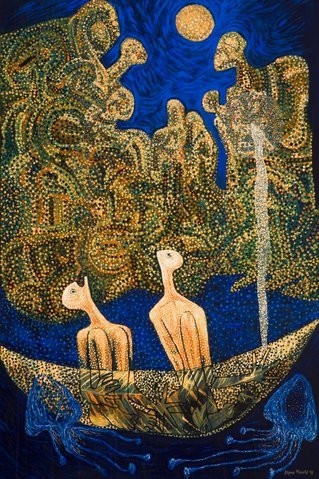
Figure 4.3. Aaron Meeks, Singing Up Country, Acrylic on canvas (2007) Online image
In the dreaming, the landscape was flat and featureless ... Ancestors came out of the land and began singing. As they did they sung up waterholes, mountains, people, animals, vegetation and country. When they had finished they lay down to become part of the landscape. This is how a person knows their country - through song. The raft is a vehicle back to the dreaming (Meeks in Brown, 2007).
Tiny dots combine to represent people and land as connected. The moon appears like an anchor to steady a flow between interacting parts. Moving through country is vital for Indigenous people to maintain connections with land and to pass on knowledge (Magowan, 2005)
Calligrapher Vikki Quill uses movement (Figure 4.4).
I approach the paper as if it was a three-dimensional space and with brush charged, I engage all my senses to bring the word to life. I imagine these fibres as lines of thought, conveying forms through ink onto paper. There is continuity between the word, the body and the mark. Dots as a way of building mass is one way I approach both the lines of calligraphy and the bridge between ink and blood (Quill, 2008).
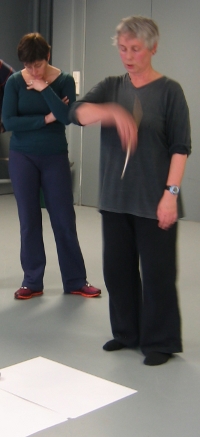
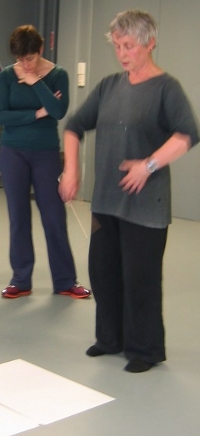
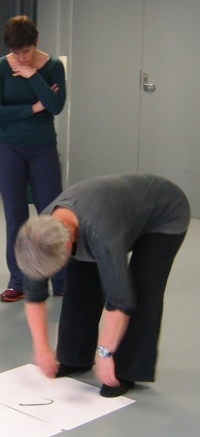
Vikki Quill demonstrates her method of calligraphy at the College of Fine Arts, University of New South Wales, 2008. Observer, Catherine Magill, dance artist
Quill uses an ancient visual language of elemental forms. As she explains: 'long before words as we know them were written, expressions of harmony with the environment were made with points and lines engraved into bones and turtle shells' (Quill, 2008). The earliest Chinese characters were conceived as representations of the three dimensional world. Points and lines, as marks most easily engraved, formed the characters used for divination, known in English as the Oracle Bone script.1
1In conversation with Vikki Quill, Sydney March 2010.
Quill's image, Earth (2005)(Figure 4.5) is an interpretation of the oracle bone script meaning Earth. Her calligraphic process combines planar and global geometries through which humans naturally know the world (Fox, 2007, p.45-46) . Fox proposes that two-dimensional symbols are used to make sense of the body's knowledge of three-dimensional experience. For Quill, the hairs of the brush are conceived as extensions of muscle fibres in the arm, and the paper is conceived as three-dimensional space. In Earth, a circle describes the world through a gesture performed in three-dimensional space. Her line has a thickness and depth that reflects a kinaesthetic experience.
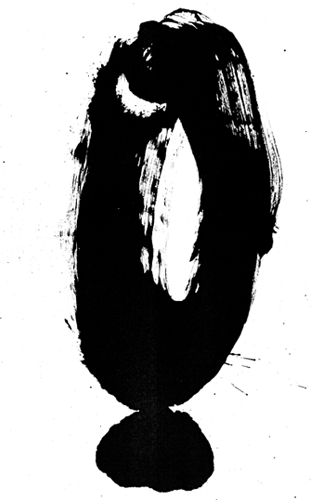
Figure 4.5. Vikki Quill, Earth, Ink on paper (2005) (Quill in Quill, 2008, Illus.)
The circle is a fundamental symbol used to make sense of physical experience. According to Jungian analyst, M. L. von Franz, the circle, or sphere, is a symbol of the self, expressing the 'totality of the psyche in all its aspects, including the relationship between man and the whole of nature' (von Franz in Jaffe, 1978, p.266).
Arts theorist Rudolf Arnheim explains that
The circle is the simplest possible shape available in the pictorial medium. Until shape becomes differentiated, the circle does not stand for roundness, but for any shape at all and none in particular (Arnheim in Watts, 1977, p.60).
A circle can represent anything experienced through the body. Whatever thing is represented, the self is a part of that.
Dance historian Lillian B. Lawler explains that the ancient Greeks designated as a dance 'the rhythmic movements of animals, of fish, of birds, of trees and flowers in the wind, of rivers, of boats on the waters' (Lawler, 1978, p.11). She cites Euripides, in his Bacchae, declaring that 'All the earth will dance'. As shown in Chapter 2, this harmonic view is reflected on the first known map of Antarctica, drawn in the time of the Ancient Greeks' (Figure 2.2). It resonates with Leonardo's idea that
While man has within himself bones as a stay and framework for the flesh, the world has stones which are the supports of the earth. While man has within him a pool of blood wherein the lungs as he breathes expand and contract, so the body of the earth has its ocean, which also rises and falls with the breathing of the world ... (Leonado in Teknoart, 2009).
In 1785, the geologist, James Hutton, 'compared the global cycling of water with the blood circulation of an animal' (Hutton in Lovelock, 2000, p.xviii) . In 1857, John Ruskin advised students of landscape art to look for 'leading or governing lines' that reflect 'vital truth', explaining that
these chief lines are always expressive of the past history and present action of the thing ... They show in a mountain, first, how it was built or heaped up; and secondly, how it is now being worn away, and from what quarter the wildest storms strike it (Ruskin, 2006, p.70).
Ruskin's view suggests a kind of geological choreography. His poetic explanation of natural forces of change reflects the scientific explanation (again poetic) of paleoecologist Dominic Hodgson who says,
I use natural records left behind in the environment to try and find out how the climate and the environment were organised in the past. And we do that by drilling into lake sediments, and we do it by drilling into polar ice and looking at cores, and we do it by drilling into marine sediments. So, pretty much like a book, the natural world (Appendix 1C).
Ruskin and Hodgson use different words to express similar processes of change. Ruskin personifies the energy flows of nature through superlatives. A mountain is struck by the wildest storms. The scientist's metaphor of the book accentuates a linear perspective. However, as we saw in Maddock's artist's book (Figure 3.25), this metaphor also lends itself to expressions of connection. Pages in a book embody layers of meaning.
Hodgson uses elaboration and repetition to explain Earth changes, when
There's lots of things being deposited out of the atmosphere, and washed into lakes, and snow falling on ice, things dying in the ocean and falling to the bottom of the ocean, and all these things build up, layer on layer on layer, making deposits that are laid down year on year (Hodgson, 2008).
Rhythmic qualities of elaboration and repetition invite a kinaesthetic engagement with the scientific explanation. When describing how sediments form, 'layer upon layer upon layer', Hodgson drew interleaving lines in the air with his hands. This spontaneous making of trace forms reflects his knowledge of how the environment is shaped through movement. Such gestural and verbal alliterations and repetitions can be animated to reflect the choreography that scientists perceive in the environment.
Laban Movement Analysis (LMA), provides a symbolic language for understanding, observing, describing and notating all forms of movement (Laban, 1973). Adaptations of Laban's theories have been used in physical theatre, dance therapy, 3D character animation and software development (Bogart and Landau, 2005);(Exiner and Kelynack, 1994);(Bishko, 2008).
Dance critic and writer, A. V. Coton explains that
Beginning with studies of ballet, of the work of Delsarte, of many kinds of folk dance, of the laws of mathematics and geometry, he [Laban] evolved a means of 'dissecting out' the basic elements which create and control every kind of movement of which the human anatomy is capable (Coton, 1978, p.11).
Laban believed that 'Dance helps man to relate to the rhythms and forces of nature' (Laban in Hodgson, 2001, p.126). His three-dimensional model, the Space Harmony Crystal (Figure 4.6), was conceived as a mental construct within which dancers kinaesthetically connect to structures within and beyond their bodies (Hodgson, 2001).
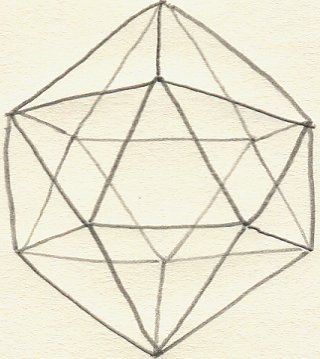
Figure 4.6. Lisa Roberts, Laban's Space Harmony Crystal (2008), Pencil on notebook paper. From Jean Newlove and John Dalby (2004)
The Space Harmony Crystal was conceived 'as an aid for spatial orientation and as a kind of model for the design and practice of his choreutic dance sequences, or [harmonic] scales' (Maletic, 1987, p.157). Maletic explains that Laban
draws close analogies between the proportions of the icosahedron (one of the five regular Platonic solids) and those of the human body, which, as found by Pythagoras as well as Leonardo, are constructed according to the Golden Section (Maletic, 1987, p. 157).
Figure 4.7 shows the 'eight' swing of Laban's Dimensional Scale, choreographed to be performed within this model. Here a whole body traces a crossing looping form like that traced by a Great Ape's arm gesture (Sydney Matthews, 2007) (Figure 4.1).

Figure 4.7. The Dimensional Scale with an Eight Swing resembles the elemental looping gesture of a Great Ape (Laban in Winearls, 1978, p.98, Illus.)
Figure 4.8 shows a drawing by Laban of one of his scales (Laban in Louppe and others, 1994, p.80, Illus.). Lines describe how flows of energy extend from within the moving body into its kinesphere.
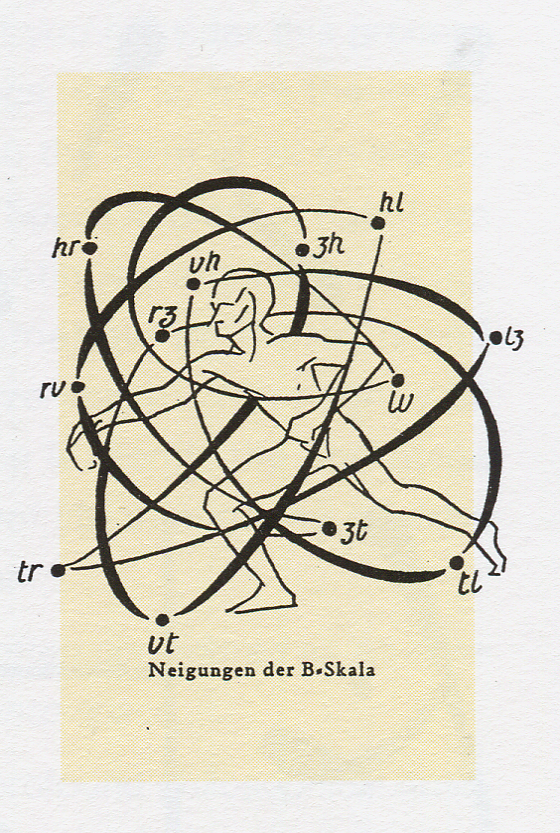
Figure 4.8. Rudolf Laban, from Sketches of the 'Scales', Laban Centre Archives, no date (Laban in Louppe and others, 1994, p.80, Illus.).
According to Exiner and Kelynack, Laban identified eight 'action drives' as the basis of all human movement (Laban in Exiner and Kelynack, 1994, p.68) (Appendix 4). No feelings, intents or beliefs, are attached to the words that describe these movements. Action drive words identify qualities of energy that flow through space and time: Float and Punch, Glide and Slash, Dab and Wring, Flick and Press. Exiner and Kelynack explain that
Laban refers to dance as the language of action, and postulates that every movement, such as an extension or contraction, is an experience in itself and does not need to have expressive connotations (Exiner and Kelynack, 1994, p.40).
Spontaneous responses are not always present. However, dance can convey the immediacy of the moment of creation, and the flows of energy that were used to shape new forms.
Dancer and choreographer, Martha Graham, explains that
Spontaneity is essentially dependent on energy, upon the strength necessary to perfect timing. It is the result of perfect timing to the Now. It is not essentially intellectual or emotional, but is nerve reaction. That is why art is not to be understood, as we use the term, but is to be experienced (Graham, 1977, p.136).
Graham proposes that balancing plasticity and tension, freedom and discipline, can 'awaken memory of the race through muscular memory of the body' (Graham, 1977, p.136). The balance of energy flow through the body has been the essence of dance through the ages.
An extension of Laban's Space Harmony theory is his Harmonic Human Movement Choir (Laban in Maletic, 1987, p.157). Here, dancers move as a united body, while as the same time sharpening their sense of themselves as individuals. Denis Kelynack explains a score for a Movement Choir that he used in his practice as a psychotherapist.
The dance begins as your body weight stirs, and gradually shifts from one foot to the other. You are gently touched by the ground through your feet. Then slowly slowly, more and more strongly, your weight bears down and you start to lift your feet and you pick up a rhythm and you start to stamp! Stamp to a loud strong beat. Take time to recognize, in your movements, the suggestion of a particular animal. Your animal is one of a herd or flock, but it is also unique in its own patterns of existence. Explore its individual patterns of movement until you feel clear what they are, and gradually let the creature go. And rest. What pleasure did you experience in the dance? What patterns in your life can you recognize in the patterns you found in the creature? Can you draw it (Kelynack, 2008)?
Drawings made immediately following dancing can reflect strong body memory. Drawing gesture (Figure 4.9), was made by the artist Rena Czaplinska immediately after performing an improvised dance (Czaplinska in Roberts, 2010). The lines appear swiftly drawn, as if made to trace an immediate body memory. They suggest flows of energy that radiate from a central core. The core is framed by larger circles and arcs that appear like some kind of creature. A range of experiences are reflected in the strong/heavy and light/soft lines. Complex contrasting qualities are unified through the central circular form.

Figure 4.9. Rena Czaplinska, Drawing gesture, Ink and charcoal on paper (2007) (Czaplinska in Roberts, 2010)
Exiner and Lloyd's circular Movement Dial (Figure 4.10) was devised, like Laban's Space Harmony Crystal, as a framework within which to observe and describe flows of human energy (Exiner and Lloyd, 1977, p.4) . Like the Human Movement Choir, The Dial can be used to improvise dances to balance a sense of individual and collective identity, and used as a score for endless variations on the theme of connectivity. Like layers of an onion, internal and external aspects of the dancer are conceived as layers within a sphere. These layers include inner attitudes, relationships to others, and to sounds within the environment. The purpose of presenting all the topics in dial form is 'to establish, at the outset, that they should always be seen as one' (Exiner and Lloyd, 1977, p.5).
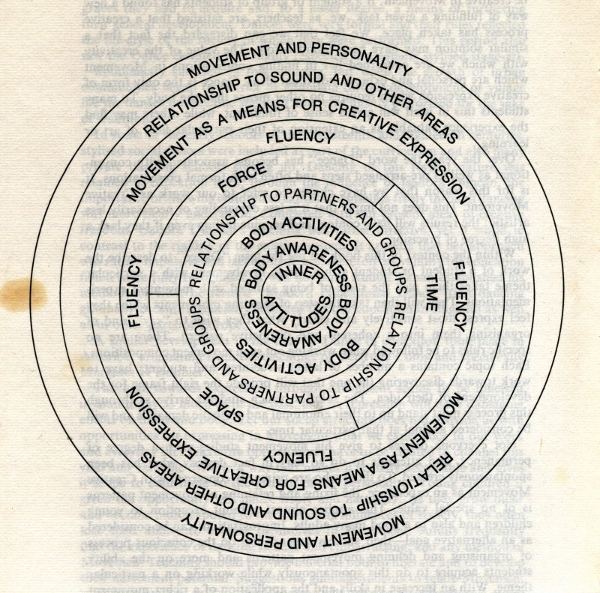
Figure 4.10. Johanna Exiner and Phillis Lloyd, Movement Dial, 1977 (Exiner and Lloyd, 1977, p. 4, Illus.)
Dance scholar Karin Bond recognises the Movement Dial as an icon of Exiner's philosophy.
I now see this as an early graphic representation of her philosophy of dance education and therapy ... Hanny's fascination with the body-mind problem and the possibility of 'whole-making' through dance occupied much of her thinking over the two decades (Bond, 2008, p.28).
Indigenous Australian artist Elaine Russell, explains that concentric circles symbolise stories that connect people, by representing watering holes and other meeting places (Russell, 2010) . They are, she reflects, 'like the lines that ripple out from a stone thrown into water, circles have no beginning and no end'. In her children's book, The Hairy One, people gather in a circle to share a ghost story (Russell and Notely, 2009) (Figure 4.11). Like frames for an animation, her pictures show people moving closer together as a story about the unknown unfolds.
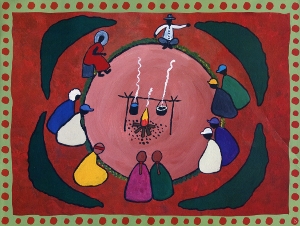
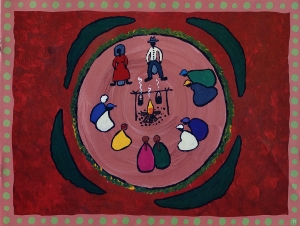
Elaine Russell, The Hairy One (Russell and Notely, 2009, p.11, Illus.)
Antarctic scholar Vanessa Collingridge explains that concentric circles, called 'cup and ring marks' were engraved into rock in Kilmartin, Argyllshire in Scotland, to mark 'limnal zones' between known and unknown regions (Collingridge, 2008). These circles are believed to represent
some kind of attempt by early humans to put their world into order. They are carved on stones which are found in borderlands ... in this case between the known coastal fringe and the unknown forests that lie inland. They are believed to mediate between the two (Collingridge, 2008).
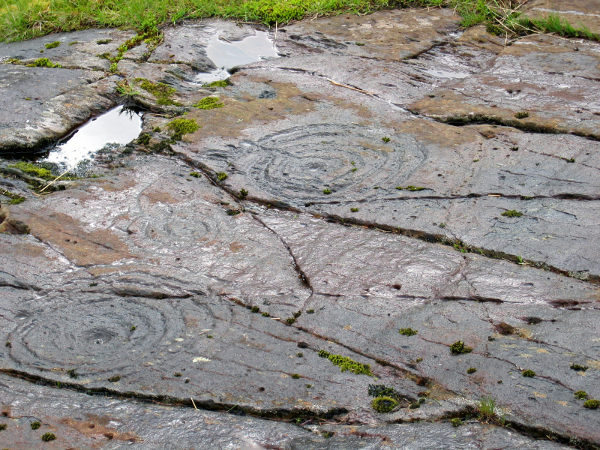
Figure 4.12. Vanessa Collingridge, Cup and ring marks in Kilmartin, Argyllshire, Scotland, 2006. Photograph courtesy Collingridge, 2008
Explorations into unknown regions of the mind parallel the first known inland Antarctic expeditions. In 1909, when Freud first lectured in psychoanalysis, Edgeworth David, Douglas Mawson and Alistair McKay, reached the South Magnetic Pole (Freud, 1931);(Allen and others, 1998, p.296) . Not long after, Carl Jung developed his theory of a universal, collective, unconscious mind, through which humanity is linked through a language of archetypal symbols (Freund, 1964, p.71).
According to Henderson, Jung identified the spiral as a symbol of transcendence, through which
a sense of completeness is achieved through a union of the consciousness with the unconscious contents of the mind. Out of this union arises what Jung called 'the transcendent function of the psyche', by which a man can achieve his highest goal: the full realization of the potential of his individual Self (Jung in Henderson, 1964, p.146).
The spiral is a symbol of exploration, including explorations to connect subjective sense with objective analysis. This symbol features in a portrait of Sigmund Freud by the artist Salvador Dali (Dali, 1938). The 'Ouvert' (opening curve) of a spiral in Freud's head suggests a conscious mind opening up to recognise unconscious thoughts and feelings. The same form may describe Dali's own journey, exploring Surrealist art.
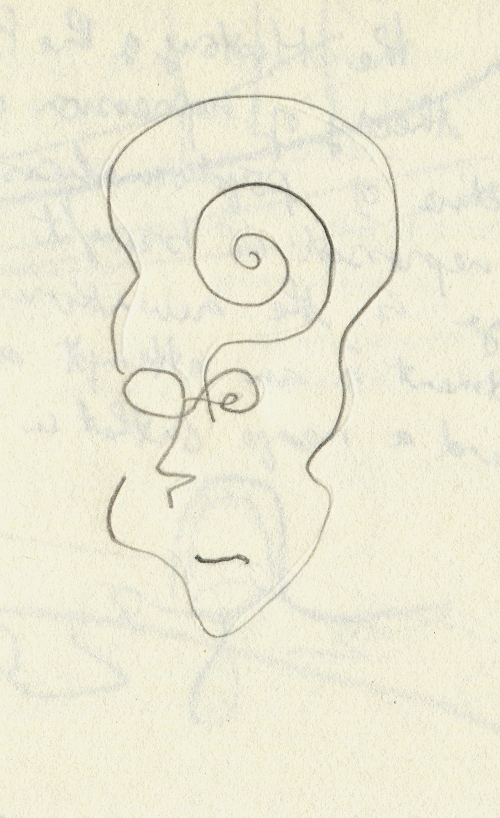
Figure 4.13. Lisa Roberts, Spiral in the head of Freud, from Dali, Pencil on notebook paper (2008)
When I drew this image from Dali's portrait, the idea arose that a spiral could be used in animation to connect a human head with a brain shaped like Antarctica. This idea resonates with a similar thought, visualised by Boissonnet (Figure 3.33). An uncoiling spiral could add energy to an icon for human conscience. An animated spiral emerging from a head could add meaning (by association) to other uses of this form to express connectivity.
Figure 4.14 shows how the spiral has been used to represent the geological history of Earth (United States Geological Survey, 2008). Earth is shown evolving through what seems infinite scales of space and time. In medieval times, 'the circle, or ring, dance, in particular, was seen as an earthly counterpart of the heavenly dance of the angels, which was itself a celebration of the Resurrection' (Jonas, 1992, p.44). There is also the tradition of physically tracing the spiral maze by finger or step, as a metaphor for life's journey, and the mandala as a path to enlightenment.
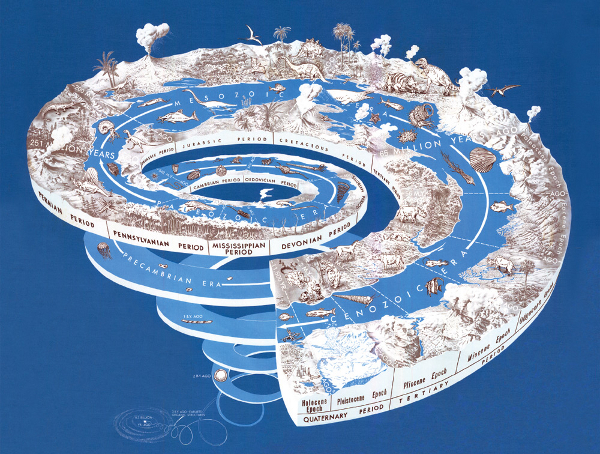
Figure 4.14. United States Geological Survey, The geological history of Earth over 4.5 billion years (2008) (United States Geological Survey, 2008) Online image
Around 1913, artists and scientists first used film to describe the reality of change (Lawder, 1975, p.14). Philosopher Henri Bergson had recently proclaimed,
there is no feeling, no idea, no volition which is not undergoing change every moment: if a mental state ceased to vary, its duration would cease to flow (1998, translated from Bergson's 1911 text).
Film appealed to Cubist and Futurist artists in the early 1900s. They found in film a working model for Bergson's theory of 'fluid time and the perception of form' (Lawder, 1975, p.20). According to arts writer, William Flemming, a remark made by philosopher Heraclitus (circa 535 to 475 BC) is said to have inspired Bergson's view (Flemming, 1974, p.352). Heraclitus once said that you cannot step into the same river twice. Flemming proposes that Bergson
often cited the motion picture as an example of what he meant by the perception of duration. The pictures in themselves are static, but through mobility the separate states are melted together by the mind into a continuous flow (Flemming, 1974, p.359).
A chronophotograph by Jules-Etienne Marey, was made in 1885 from simultaneous rather than sequential film images (Marey in Lawder, 1975, p.9, Illus.)(Figure 4.15). Marey's images are thought to have provided a model for such artists as Marcel Duchamp and Giacamo Balla (Lawder, 1975, p.9-10).
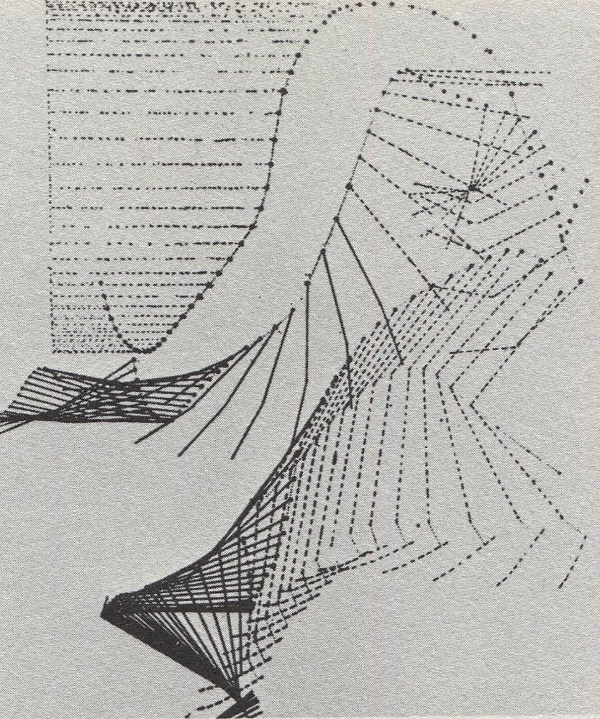
Figure 4.15. Jules-Etienne Marey, Diagram of a Jumping Figure, from a Chronophotograph (c.1885) (Marey in Lawder, 1975, p.9, Illus.)
Figure 4.16 shows images from a film made in 1910 by the physiologist Jean Commandon, to capture the motions of live bacteria and microbes. In 1912 the film was described by one viewer as 'startling to such a degree as to be incredible' (Lawder, 1975, p.14).
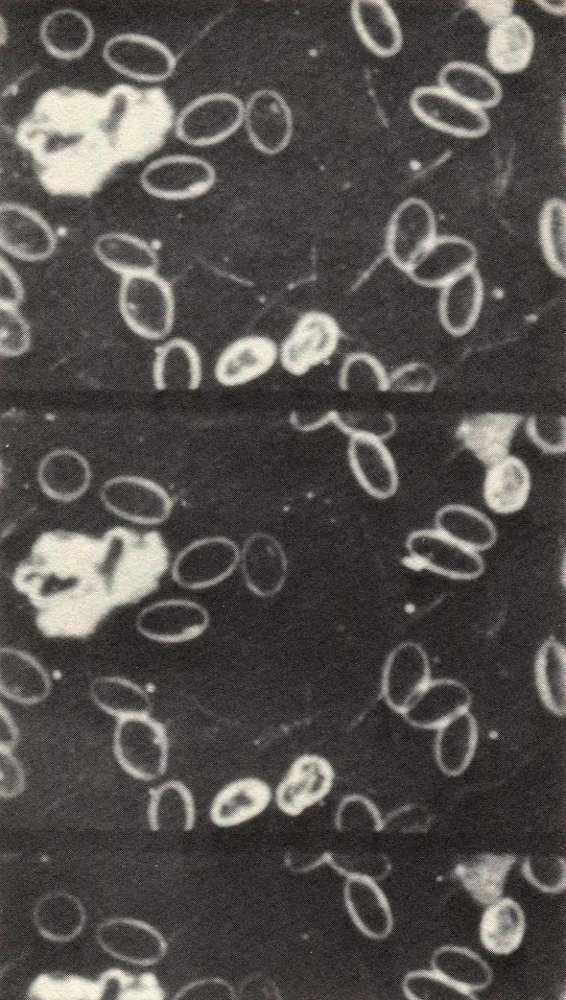
Figure 4.16. From F. A. Talbot, Moving Pictures, London (1912) (Lawder, 1975, p. 16, Illus.)
These early films, Lawder speculates,
no less than the pre-war paintings of Kandinsky, must have been experienced by sensitive minds as profound and uniquely modern revelations of an unknown world - images of organic forms in movement recalling the telescopic views of swirling galaxies, full of the flux and flow of life itself, touching at the core of secret meanings of the universe, and, at the same time, paradoxically, palpably real, that is, objectively verified by moving photographic images of a biological, if not spiritual, inner life (Lawder, 1975, p.14).
The paradox is that objectively verified views can inspire spiritual awe when they are simultaneously perceived at an aesthetic (sensory) level. Such responses can be useful for connecting us to the awesome issue of climate change. In her report of the conference, Creating a Climate for Change, environmental scientist, Susanne Moser, proposes that generating emotional responses to climate change information is vital 'to engage people in envisioning a future worth fighting for' (Moser, 2007, p.75). However, she warns of 'the danger of unhampered and unattended emotions' (Moser, 2007, p.67). At worst it can lead to 'psychic numbing or apathy' (Moser, 2007, p.68).
Figure 4.17 shows a key moment in the film, An Inconvenient Truth, when ex-US president, Al Gore, positions himself within the climate change data that he presents (Gore in Wowkodos, 2006-2007) When standing between scientific graphs that correlate rising temperatures with levels of CO2 in the atmosphere, Gore gestures an invitation with his hands to attend to this visual evidence. He physically rises in a scissor lift to reach the point in the graph that shows where levels of CO2 are predicted to reach in less that 50 years. This highly choreographed and potent gesture speaks to us at a visceral level.
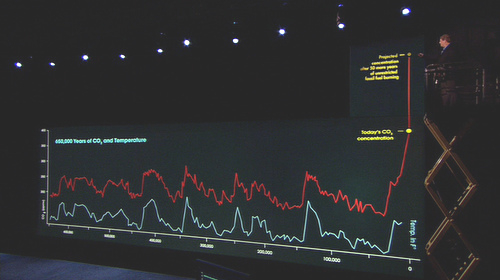
Figure 4.17. Al Gore, An Inconvenient Truth, Images from Gore's presentation (2006) (Gore in Wowkodos, 2006-2007, Illus.) Online image
Improvisation can be used in animation to simulate the seemingly spontaneous forming and reforming of the Antarctic environment. Helmi Vent and Helma Drefke describe a process of choreography based on improvisation as a means of exploration and 'spontaneous forming' of dance compositions:
Playful searching, experimenting, collecting of experiences and impressions with/through various possibilities of action and expression in movement
Finding (out), inventing and 'retaining' committing to memory of movement forms, motives and short sequences
Repeating, practicing, in certain circumstances improving of movement forms discovered through exploration/improvisation ... during which improvised and reproduced segments alternate, interweave and compliment one another
Varying and combining of the found and selected movement motives and themes
Composing/forming of the processed movement material with intentional consideration of compositional criteria
Reproducing, repeating, reinforcing of one's movement composition (Vent and Drefke in Exiner and Kelynack, 1994, p.84)
As early as 1908, artist Emil Cohl had used improvisation techniques to animate his film, Fantasmagorie (1908). Figure 4.18 shows how simple lines appear to spontaneously form from beneath the artist's hand, which appears and disappears as a story unfolds. The artist's hand is revealed as part of the action. Attention is focused on the act of creation as much as on the lines being drawn. This sets up a resonance between what is real and imagined. The line between the creator and creation is merged.

Figure 4.18. Emile Cohl, Fantasmagorie, Animated film (1908), (Cohl in Leslie, 2002, p.3, Illus.)
Animation is a compelling medium. It can convey sensations that defy logical explanation. For animator, Norman McLaren, Cohl's technique of metamorphosis was
a revelation. Here was animation at it's purest and best. It seemed like the quintessence of animation, unadulterated and unaffected by ideas and methods of other media and earlier times. It rejoiced in the fact that it was drawn with a line, and that the line could move. It breathed with this knowledge, and it followed the logic of it (McLaren in McWilliams, 1991).
McLaren recognised the non-linear logic of the unconscious dreaming mind. He also found, in Sergei Eisenstein's films, methods that represent human perception.
Cutting from one thing to another is rather like the mental process of the human being. It's instantaneous ... In the sudden juxtaposition of two things very different from each other, as in a dream, the spirit is able to jump around with extreme rapidity, in spite of the laws of logic (McLaren in McWilliams, 1991).
McLaren identified his own artistic approach in Surrealism, which he defined as 'cutting down the conscious control of what was happening'. His improvisation methods included painting directly onto clear movie film (Figure 4.19), where
the subconscious plays a very important role. It perhaps has the whole thing pretty well formed from start to finish. It's a matter of the consciousness not knowing that form, but creating it (McLaren in McWilliams, 1991).

Figure 4.19. Norman McLaren working at the National Film Board of Canada (1944, Illus.) Online image
McLaren combined landscape and human forms in his animation, Landscape (McLaren in McWilliams, 1991)(Figure 4.20). Landscape presents a European scene as if spontaneously forming through geological time. Transformations between human and land forms are dream-like, gentle, diffused and gradual. They describe our continuing primal connections.
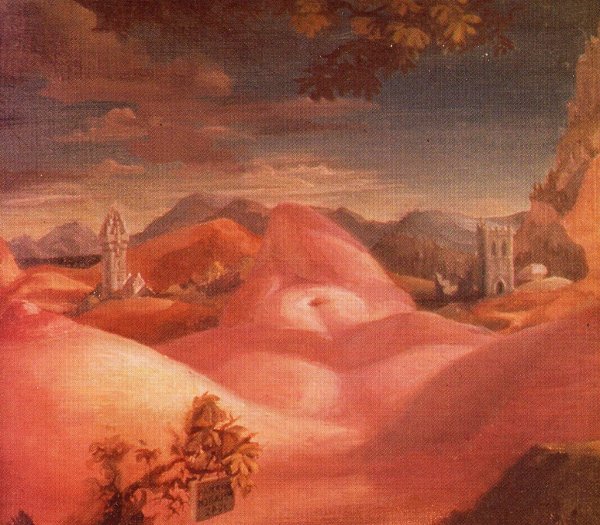
Figure 4.20. Norman McLaren, Landscape (no date) (McLaren in McWilliams, 1991)
Figure 4.21 shows animator, Len Lye's image, Drawing (Sea) (c.1930). It illustrates his 'fascination with the sea as a mysterious and primal underworld' (Len Lye in Cann and Curnow, 2009, p.xiv, Illus.). Both McLaren and Lye animated with spontaneously formed drawings. Lye also recognised similarities between his spontaneously formed lines and scientific representations of physical and biological systems.
-600x401.jpg)
Figure 4.21. Len Lye, Drawing (Sea), Pencil on paper (c.1930) (Len Lye in Cann and Curnow, 2009, p.xiv, Illus.) Image courtesy of the Len Lye Foundation
For arts writers Cann and Curnow,
Lye found connections between his early drawings and scientific representations of cellular and cosmological processes. In these likenesses he suspected a form of intuition that connected all human knowledge from the beginning of time, which he called the 'old brain' (Cann and Curnow, 2009).
The 'old brain' is Lye's term for
the unconscious contained within the genetic code and the evolutionarily older reaches of the brain governing the body. Lye believed this 'mental link to the whole bodily matrix of our make-up' was accessible through art-making techniques that subvert the conscious, rational 'new brain' (Cann and Curnow, 2009, p.162).
Lye made his first animation, Tusalava (Just the Same) in 1929, 'trying to imagine the kind of film that might have been conceived by an ancient Aboriginal artist' (Lye in Brett, 2009, p.50). Figure 4.22 shows Lye's meticulously hand-drawn dots and lines that express celestial motions, biological and physical systems, components of a machine. Tyler Cann notes that Lye's work displays a preoccupation with 'conflating the biological and the geological, the mechanical and the sexual' (Cann, 2009, p.67).
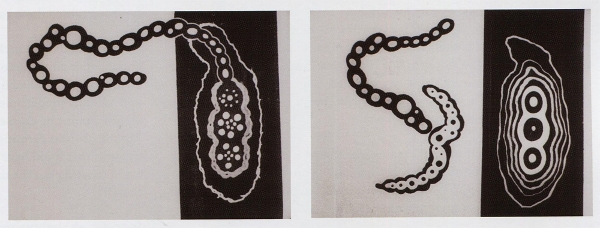
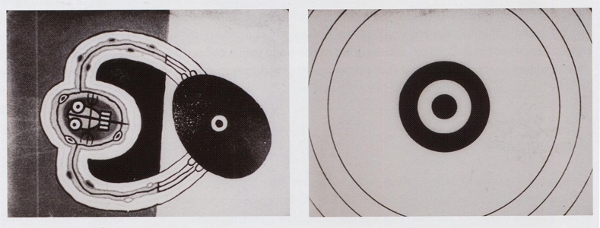
Figure 4.22. Len Lye, Tusalava (Just the Same), Animated film (1929) (Cann and Curnow, 2009, p.69, Illus.) Image courtesy of the Len Lye Foundation
In the final scene of Tusalava, centrally placed concentric circles lead the eye inwards, as if on a mandala. Two figures emerge, transform, and envelop each other. Like the 'people and things at war with each other' in Cohl's Fantasmagorie (Figure 4.18), Lye's forms appear engaged in some kind of ancient combat ritual. The feeling of division is sharpened by the contrast between black and white. Yet the forms also merge, evolve, and emerge as new forms through membranes that once divided them. They separate and reintegrate as if to perpetuate cycles of change within a unified system.






















